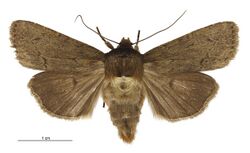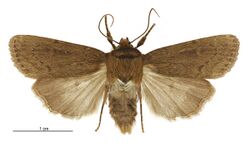Biology:Bityla defigurata
| Bityla defigurata | |
|---|---|

| |
| Female | |

| |
| Male | |
| Scientific classification | |
| Domain: | Eukaryota |
| Kingdom: | Animalia |
| Phylum: | Arthropoda |
| Class: | Insecta |
| Order: | Lepidoptera |
| Superfamily: | Noctuoidea |
| Family: | Noctuidae |
| Genus: | Bityla |
| Species: | B. defigurata
|
| Binomial name | |
| Bityla defigurata (Walker, 1865)[1]
| |
| Synonyms[2] | |
| |
Bityla defigurata is a moth of the family Noctuidae.[1] It is endemic to New Zealand.
Taxonomy
This species was first described by Francis Walker in 1865 using specimens collected by T. R. Oxley in Nelson and originally named Xylina defigurata.[3] Edward Meyrick placed this species in the genus Bityla and synonymised Bityla thoracica with this species.[4] The female holotype is held at the Natural History Museum, London.[2]
Description
Walker described this species as follows:
Female. Cinereous-brown. Head and fore tegulae of the thorax dark brown. Palpi dull ochraceous, fringed beneath, obliquely ascending, rising a little higher than the vertex ; second joint mostly black on the outer side ; third elongate-conical, about one-third of the length of the second. Abdomen brownish-cinereous, extending rather beyond, the hind wings; apical tuft ochraceous. Wings shining, tinged with aeneous. Fore wings with some indistinct brown lines composed of lunules ; orbicular and reniform marks indistinctly brown-bordered. Hind wings a little more cinereous than the fore wings. Length of the body 10 lines ; of the wings 22 lines.[3]
Distribution
It is endemic to New Zealand and found in both the North and South Islands.[1][5]
Behaviour
The adults of this species are on the wing from January to March and is attracted to light.[5]
Host species
The larvae of this species have been reared on Muehlenbeckia australis and Muehlenbeckia complexa.[6]
References
- ↑ 1.0 1.1 1.2 "Bityla defigurata (Walker, 1865)". Landcare Research New Zealand Ltd. http://www.nzor.org.nz/names/c340ebdf-2d89-4991-a5af-3655b136e697.
- ↑ 2.0 2.1 , pp. 195, Wikidata Q45083134
- ↑ 3.0 3.1 , Wikidata Q113265208
- ↑ , pp. 31, Wikidata Q104048034
- ↑ 5.0 5.1 , pp. 29, Wikidata Q19073637
- ↑ "PlantSynz - Invertebrate herbivore biodiversity assessment tool: Database". https://plant-synz.landcareresearch.co.nz/ReportForm.aspx?RecordId=1573&Type=H&ReportType=Adv&SortBy=Alpha&Biostatus=a,c,e,n.
Wikidata ☰ Q13439662 entry
 |

